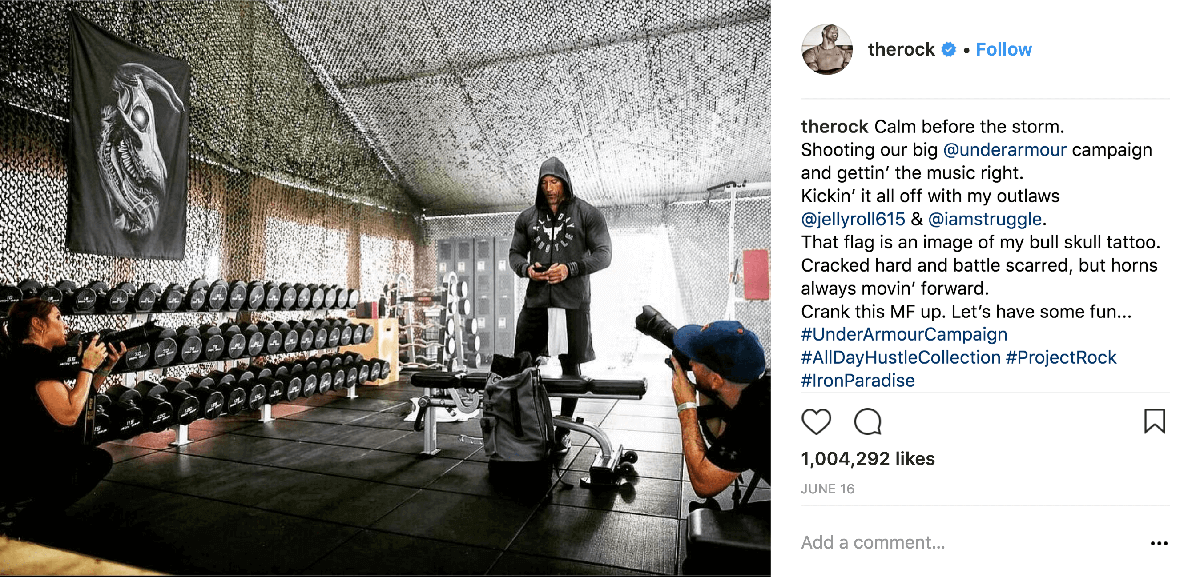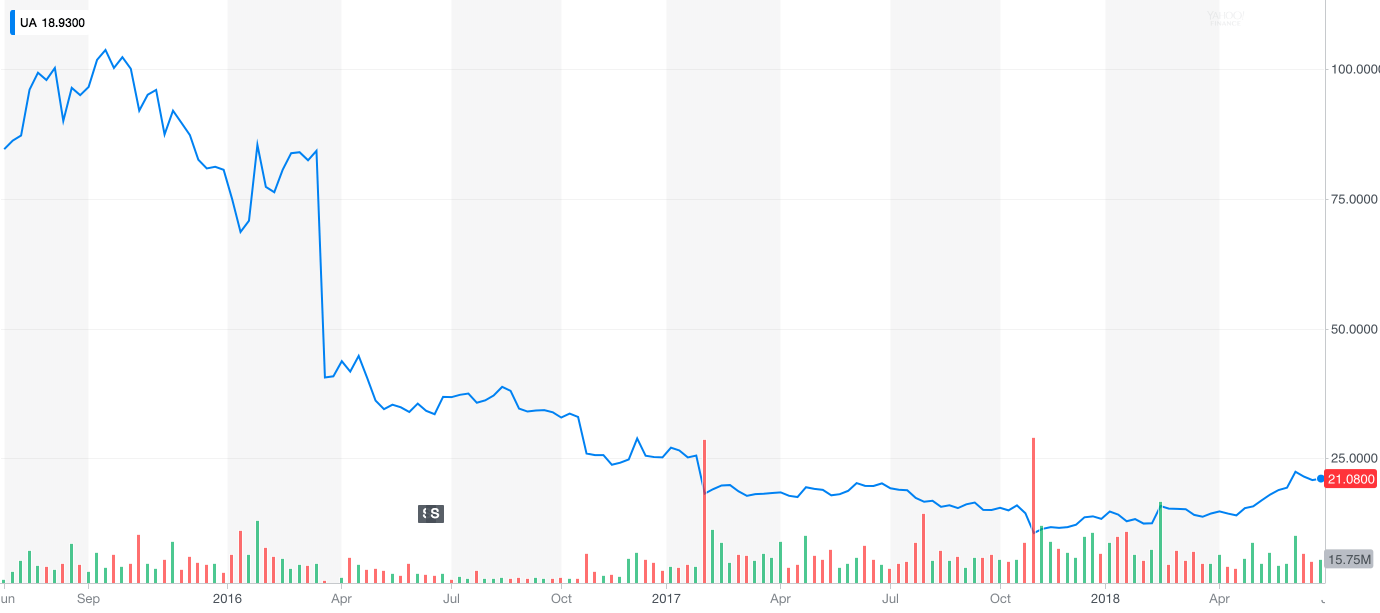It’s Saturday morning at 5:00am and Dwayne “The Rock” Johnson is live streaming on Instagram from his @TheRock account. He’s in what he calls “The Traveling Circus” or “Iron Paradise”, an envy-worthy gym big enough for twenty athletes contained in a giant, white tent. The gym moves with him around the world, from location to location. In the last year alone he’s taken it across the world filming and promoting a reboot of Jumanji, while simultaneously starring in action movies Skysraper and Rampage. 
The Rock takes a full gym with him on the road, using it to broadcast social media video and posts of work with Under Armour.
The Rock flashes his signature porcelain-white smile as he gives his audience of over 100 million followers a sneak peak at new product. He holds up a futuristic-looking grey and black sneaker, “Guys I wanna show you progress on the new kicks. I’m putting these things through the ringer to make sure they’re ready for you. No half-assing and no quitting until they’re perfect. Stay tuned and I’ll let ya know when they drop.”
The Rock is referring to an ongoing brand collaboration with athletic apparel brand Under Armour. Featuring a masculine line of gym clothes, sneakers, and now Bluetooth headphones, The Rock’s products may be what the ailing brand needs to get back in the game.
A year ago, Under Armour’s stock was at an all time low. Revenue forecasts looked grim, and retail sales were down. The consensus on Wall Street was clear: We’ve reached peak interest in overpriced athletic products. A trend started over a decade ago by Lululemon, it seemed America had tired of $80 wicking t-shirts. Even legacy brand Nike suffered against challenger brands like A Bathing Ape, which seemed to be the only bright patches of growth in a chilly retail environment.

After a tremendous fall in early 2016, UA has only now begun to turn around with help from celebrity super-promoter The Rock.
But as the casual retail segment found it’s way back to normal, Under Armour lagged behind. But as it turns out, sales numbers were only half the story.
On a conference call in early 2017, UnderAmour CEO NAME noted that sales across the athletic apparel industry were grim, and not likely to improve any time soon. Under Armour’s stock plummeted 30% in volatile after hours trading. Many Wall Street analysts downgraded the stock, and led to further speculation. It seemed the Baltimore, MD-based company was just a few quarters away from bankruptcy, or total failure. A new line of pricy apparel wasn’t selling, and the company didn’t seem to have brand footing in social media the same way Nike did.
The important Millennial shopper was choosing trendier or more socially-conscious brands. As an example, same-priced Lululemon was doing well. Analysts noted this, and that there must be something very wrong at Under Armour.
Enter the Brand Collaboration
The trend of brand collaboration is nothing new. In fact, brands have been bringing celebrities on to assist with marketing for ages. In the atheltic apparel segment, the most famous is Michael Jordan’s collaboration with Nike to produce sneakers. That collaboration still produces billions in annual sales for the company, and has one of the most iconic logos in the world.
But throughout the early 2000’s, brands strayed away from the format. The idea of bringing on top sports players never really went away, but it wasn’t growing either. There was risk as well. In a society increasingly aware of gender and social injustices, the risk of a scandal could greatly outweigh the benefits of added sales. To top it off, social media was beginning to show strength in marketing, allowing anyone with a following to deliver a recommendation or product to millions.
So what makes the right brand ambassador better than a run of the mill celebrity or athlete? It’s a cocktail of brand fit, personality, and content, and it can be incredibly potent when harnessed. Architecting the Under Armour Turnaround
When The Rock signed on to represent Under Armour in early 2017, nobody batted an eye. As far as Wall Street analysts were concerned, it was another attempt by the ailing brand to become relevant again, and likely would not succeed. The American public likely had no idea the deal was inked. Under Armour didn’t do much to promote the collaboration either. There was no advertising campaign. There was no major event or press conference. There was a paltry corporate press release placed deep in the Under Armour website, likely to comply with FINRA regulations.
But there was a group of people who knew all about it: The Rock’s 70,000,000 (at that time) Instagram followers.
In what has become his signature amateurish style, The Rock announced the collaboration on a self-recorded video. Immediately fans began sharing congratulations and parroting The Rock’s personal mantras like, “Never quit. Never surrender. Hard word pays off.”
In a way, The Rock had already built what Under Armour wanted but never could: A devoted group of loyalists focused on self-improvement. This was the defining moment in a billion dollar turnaround that would see Under Armour bounce back from certain doom.
Becoming the Brand: Causes and Meaning
Companies have never been in a more precarious position. On the one hand, brands must capture and maintain a sense of cool. This used to come from trendy advertisements and strategic placements with celebrities. In the modern marketing world, it means working with countless social media influencers and brand ambassadors to stay in the game.
But, brands must also stand for something that matters to consumers. Patagonia wants to save the world. Tom’s wants to give shoes to underprivileged kids. Without a cause and without a real message to deliver, a brand can quickly find themselves on the other side of a double-edged sword. Before The Rock, Under Armour may have been riding the edge of that very blade.
As it turns out, Under Armour found perhaps the one celebrity that could save the company with presence alone. So what did The Rock bring that nobody else could?
Let’s revisit that 5:00am workout session. The Rock has cultivated a brand unlike any other, and grown it by living the mission. He’s regularly showing off shirts, shoes, gym equipment, and now his claim of the best Bluetooth headphones for working out. And despite what digital marketing gurus are saying about self-promotion and social media, his fans are loving it. If you follow him on Instagram, you’ll immediately understand how this has all come to pass. One evening he shares long form stories of mistakes he made as a young man, and the lessons he learned from those mistakes. The next morning he congratulates a sizable team for work well done, while in the same post warning that there’s no time for a break. And that evening he’s recording a special video to a young female fan wishing her a happy birthday. The next day? You guessed it: Back in the gym at 5:00am.
The Rock presents as a father figure, CEO, and hustler all in one, muscle-bound package. And the world loves him for it. None of this works if The Rock is embroiled in scandal, or butting heads with authorities. And despite using a range of explicative on social media – both written and in video content – he is squeaky clean. Perhaps that’s part of the magic of why his rebellious, go your own way image pays off. It certainly has for Under Armour and any other commercial property associated with him.

